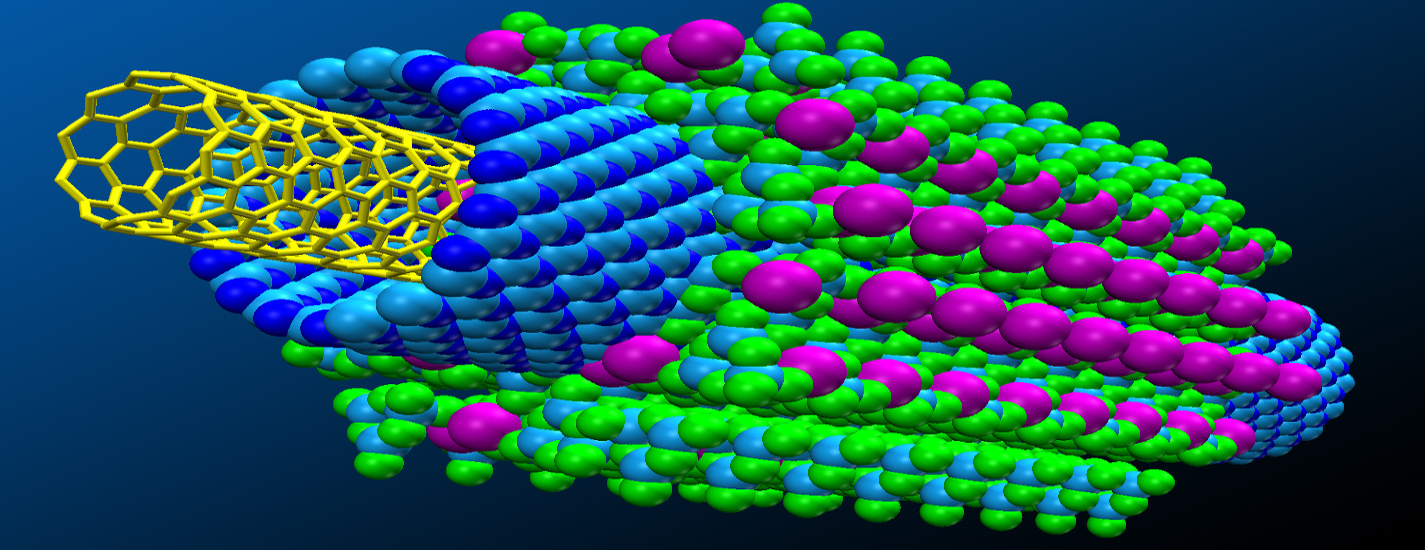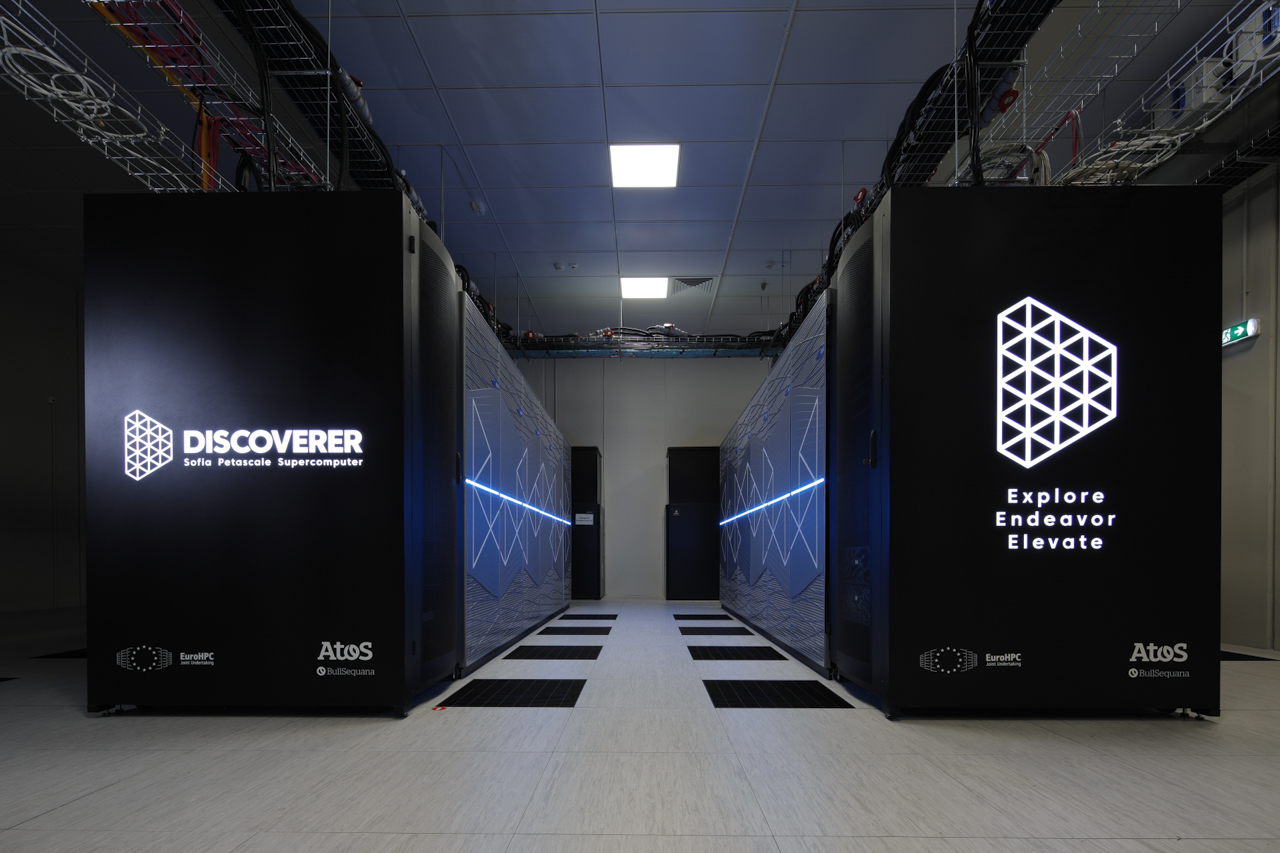Researchers in the EU and UK make
strides in demonstrating combustion
performance of e-fuels by using supercomputers
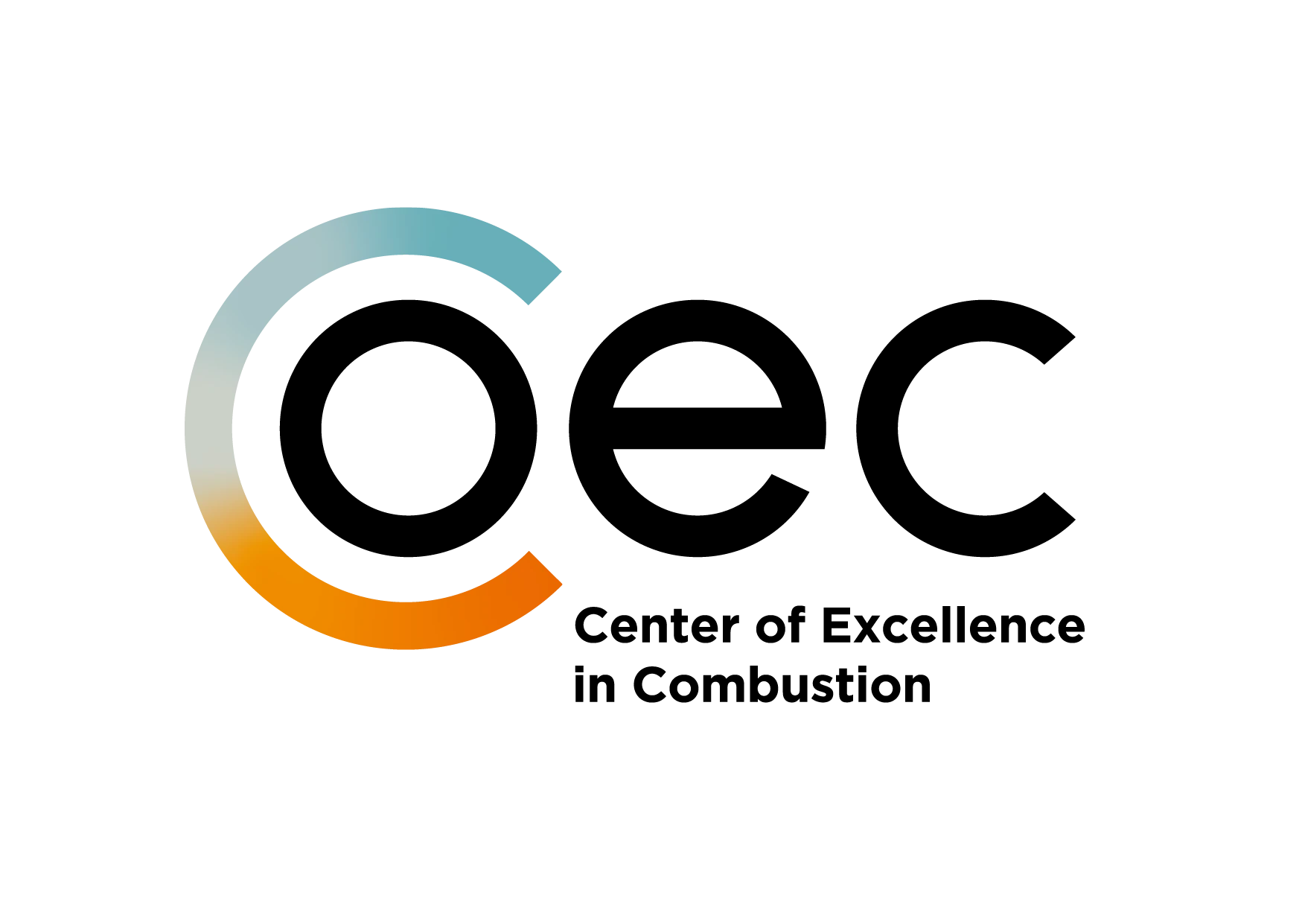
Utilizing cutting-edge supercomputing technologies, scientists from the European Union and the United Kingdom are making remarkable advances in facilitating the deployment of sustainable fuels for the future. Their collaborative efforts, spearheaded by the Center of Excellence in Combustion (CoEC), focus on using advanced modelling and simulation technologies to study the combustion of sustainable fuels and new combustion technologies. They aim to transform Europe´s power and transportation sectors, fostering the creation of the next generation of eco-friendly fuels.
Addressing challenges in computational combustion, the CoEC project has achieved groundbreaking results in the past three years. Formed by a consortium of 11 institutions, including supercomputing centers, laboratories, and universities, CoEC has been created to apply exascale computing technologies to promote and develop advanced simulation software that support the decarbonisation goals of the European Union within the energy and transportation sectors.
The reasons for that collective effort have been substantial. The transportation industry is responsible for 20% of the world's CO2 emissions, making it the second-largest contributor to global carbon pollution, as stated by the International Energy Agency. That is why, at COP28 in November 2023 in the United Arab Emirates, nearly 200 countries agreed to a transition “away from fossil fuels in energy systems in a just, orderly, and equitable manner, accelerating action in this critical decade to achieve net zero by 2050 in keeping with the science”.
“CoEC is primarily driven by the need for energy transition, and it is aligned with European decarbonisation objectives, which deal with fundamental problems posed to our community, such as the need for new fuels and how these fuels perform in various systems. Additionally, CoEC explores any possible modifications needed for current engines to use them more efficiently”, says Daniel Mira, CoEC coordinator and senior researcher at the Barcelona Supercomputing Center (BSC). The project also addresses innovative applications, particularly focusing on redesigning combustion systems, with a primary emphasis on utilizing hydrogen across various sectors.
“I believe that combustion science can help produce novel propulsion and energy technologies”, explains Epaminondas Mastorakos, CoEC team leader and Hopkinson/ICI Professor of Applied Thermodynamics at the University of Cambridge. “And it is not only the new fuels – it is also battery fires, wildfires, material synthesis, and other problems that fall within our remit. We can play a major role in changing the world for the better”.
Hydrogen combustion
Scientists involved in the project have achieved remarkable, indeed unthinkable results, with one notable breakthrough linked to hydrogen combustion.
Introducing new fuels, such as hydrogen or sustainable aviation fuel, can significantly reduce carbon-related emissions, reaching net zero in the case of hydrogen combustion. For instance, high-fidelity simulations were conducted to explore hydrogen combustion using a lab-scale gas turbine combustor model that had been experimentally characterized at TU Berlin. The numerical results from these simulations contributed to understanding the primary characteristics of the flame and major chemical pathways for NOx formation, shedding light onto its stabilisation mechanisms, and revealing insights into flame resistance. Throughout this journey, the CoEC project has also facilitated the development of various software and methodologies to assist industrial partners in designing the next generation of hydrogen turbines for power generation and aviation propulsion. These tools can also support the operation and optimisation of wind farms and enhance the efficiency of chemical reactors.
Net-zero carbon emissions
Another key breakthrough is associated with the aviation sector's transition to net-zero carbon emissions. In the quest for net-zero carbon emissions in the aviation sector, this breakthrough involves understanding soot formation in aero-engines, as the emission of these carbon nanoparticles poses risks to both human health and the environment. Collaborative efforts between BSC and TU/e, RWTH Aachen, TU Darmstadt, ETH Zurich and AUTH conducted numerical studies of soot formation in lab-scale combustors, combining simulations and experimental measurements to elucidate mechanisms governing soot emissions and performing Direct Numerical Simulations that can provide fundamental understanding of soot formation in practical applications. Numerical results guide the development of mitigation strategies, offering valuable insights for optimising the burner's operation and limiting the emission of soot particles.
Additionally, CoEC has pioneered High-Performance Computing codes to explore the combustion of iron powder and hydrogen. This cyclic, carbon-free fuel holds the potential for storing and transporting renewable energy, and a deep understanding of its combustion is crucial for developing burner technology. Simulations of combustion of iron particles in CoEC's codes has provided insights into iron powder flames, opening avenues for simulating iron powder combustion in industrial applications. The prediction of soot pollutant emissions, a complex challenge involving multi-phase processes and intricate physicochemical mechanisms, is addressed successfully in the study. This research has significant implications for developing low-emission aero-engines, particularly those fueled by Sustainable Aviation Fuels (SAF).
“To avoid the emission of carbon oxides, the most direct solution is to burn fuels that do not contain carbon, says Dr-HdR Bénédicte Cuenot, the leader of the combustion research group at CERFACS, France. CERFACS has developed advanced and massively parallel software for the numerical simulation (DNS and
LES) of turbulent combustion and heat transfer (including thermal radiation) in industrial systems. According to Dr Cuenot, these fuels must be easy to find and burn; Hydrogen, Ammonia, and metal powders are among the good candidates. “But they require redesigning all industrial systems. This can be made via numerical simulation, which has become essential for innovation”, adds Bénédicte Cuenot.
Exascale-scale simulations
Another exciting project result is connected to the visualisation of the extreme amount of data from exascale-scale simulations of nekCRF. Exascale supercomputers are the most powerful high-performance computers available today. One such system, called JUPITER, will be built in Europe in 2024 and hosted at the Jülich Supercomputing Centre (JSC), Germany. All exascale supercomputers use GPUs for most of their performance, in contrast to petascale systems that use CPUs for most of their performance. Simply optimising code developed for CPU systems to run efficiently on GPUs is typically impossible. Therefore, new simulation codes must be developed, which is highly non-trivial for complex simulations such as combustion applications.
Several partners of CoEC, such as ETHZ, AUTH, and FZJ, have enabled the reactive flow solver nekCRF, designed to make the most efficient use of the latest GPUs. nekCRF allows complex combustion applications to be computed with unprecedented degrees of freedom that significantly accelerates the time to a solution. A particular focus has been placed on optimising nekCRF for the hardware of Europe's first exascale supercomputer, JUPITER, to enable one of the largest combustion simulations in the world and the largest ever in Europe. Using the nekRS framework, nekCRF also benefits from other CoEC developments, such as our novel pipeline for in-transit visualisation. This visualisation pipeline helps manage the extreme amount of data from exascale-scale simulations and was recently recognised with the Best Paper Award at ISAV23 during the Supercomputing Conference 2023.
“Simulation has become the third scientific pillar alongside theory and experiment. We are just at the beginning of developing hydrogen aero gas turbines”, says Christian Hasse, Professor in the Department of Mechanical Engineering at the Darmstadt University of Technology, Germany, and one of the team leaders of CoEC. “The combination of unique experiments and, particularly important for CoEC, high-performance computing, provides insights into combustion processes that were unthinkable ten years ago”, completes Hasse.
About CoEC
CoEC is a collective effort to exploit Exascale computing technologies to address fundamental challenges related to the simulation of combustion systems, which will create a positive impact on the EU´s decarbonisation goals. Coordinated by the Barcelona Supercomputing Center and granted with a budget of over €5.6M by the European Commission, the project ran from 1 October 2020 to 30 December 2023.
Other partners in the consortium include leading institutions in the fields of computational combustion and High-Performance Computing such as Centre Européen de Recherche et de Formation Avancée en Calcul Scientifique (CERFACS), RWTH Aachen University, Eindhoven University of Technology, University of Cambridge, Centre National de la Recherche Scientifique (CNRS), Technical University of Darmstadt, ETH Zürich, Aristotle University of Thessaloniki, Forschungszentrum Jülich (FZJ) and National Center for Supercomputing Applications.
CoEC Combustion Autumn School 2023
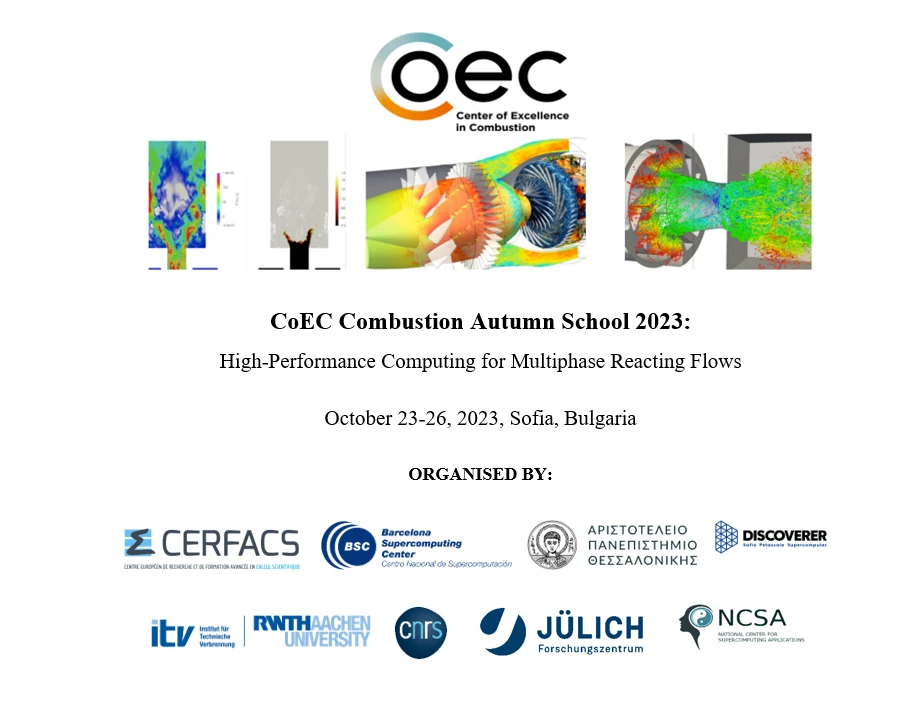
Description: CoEC Combustion Autumn School 2023: High-Performance Computing for Multiphase Reacting Flows will start with an introduction to the Navier-Stokes equations and the numerical approaches for their solution. In the following two lectures, we provide a quick overview of combustion chemistry and an introduction to chemical kinetics and the Arrhenius law. The main portion of the lectures will focus on the fundamentals of laminar flames, premixed and non-premixed. The final part will explore the interaction of turbulence and combustion, introducing relevant dimensionless numbers (e.g. Karlovitz and Damköhler) and the different regimes of premixed turbulent combustion. During the first day, we will continue with computational approaches for the simulation of combustion systems: DNS and LES of mixing and combustion. Numerical approaches, low Mach vs. fully compressible, depending on the application will be covered. There will be presented examples from DNS of combustion systems including premixed and non-premixed and flame propagation in ICEs and RQL type burners.
The second day, program will continue with the presentation of the world of high-performance computing (HPC). We will start with a historical overview of HPC, tracing the evolutionary journey of hardware, programming methods, and models that have culminated in the current state of high-performance computing. A primary focus will be on performance optimization, exploring the transition from standard processors (CPU) to general-purpose graphical processing units (GPUs). By shedding light on these advancements, participants will develop a deeper understanding of the potential and capabilities that HPC offers and how to use it.
In the last two days of the event, we will cover the topic of the machine-learning assisted combustion simulations and will introduce meshing theory, mesh adaptation theory, parallel mesh adaptation and mesh parametrization for fronts and interfaces. A special part of the event will be the hands-on sessions during the last day of the event. YALES2 software will be used for demonstration of variable density flows and finite-rate chemistry.
This is the third training course in a series of CoEC seasonal schools as part of the CoEC project. The CoEC Autumn School 2023 is joint effort by CNRS (France), CERFACS (France), AUTH (Greece), BSC (Spain), Institute of Combustion Technology (ITV) - RWTH Aachen University (Germany), JSC (Germany), PetaSC/Sofia TechPark (Bulgaria) and NCSA (Bulgaria).
What you will learn / best practices & applicability
- Introduction to the Navier-Stokes equations and the numerical approaches for their solution;
- Presentation of major discretization methods used in practice;
- Introduction to fundamentals of combustion;
- Why use high order methods (HOM) for high fidelity simulations (DNS, LES);
- Accuracy and cost of HOM; HPC scalability and performance aspects;
- Presentation of best practices for designing efficient HPC applications with focus on performance optimization, exploring the transition from CPU to general-purpose (GPUs);
- Insights into the techniques and strategies that drive successful HPC application development with illustrative examples of porting codes to modern GPUs using OpenACC;
- Introduction to Dynamic Mesh Adaptation for fronts and interfaces;
- YALES2 hands-on sessions include:
- Introduction: mesh management, run setup, finite-volume schemes, data structures;
- Time integration of the low-Mach Navier-Stokes equations;
- Hands-on: Rayleigh-Taylor case;
- Tabulated chemistry models;
- Hands-on: 1D flames, 2D flames;
- Finite-rate chemistry: Governing equations, time splitting methods, stiff integration and algorithms for massively parallel solving, dynamic mesh adaptation;
- Hands-on: 2D and 3D flames;
- Spray combustion and hands-on.
Target audience: Under-graduate and graduate students, Ph.D. students, junior researchers (academy and industry) with some knowledge in Computational Fluid Dynamics (CFD). Attendees should have basic computer management skills and be able to work comfortably on the Unix/Linux command line, notion of compilers and build procedures.
Selection process: There is a threshold number of participants (no more than 40 registrations), timely registration is essential. We will stick to the following criteria:
- 80% for attendees from institutions (universities, research centers, and companies) based in the EU or Associated Countries to the Horizon 2020 Programme and 20% for others.
- If the threshold is exceeded, we will prioritise attendees from South-East Europe, Israel, and Ukraine as well as participants that come from EU13 countries.
Programme: Click here.
Cost: There is no registration fee. The CoEC event is free of charge.
Registration: Please, click here
Registration deadline: October 17, 2023.
For any further information, please feel free to contact us @ g.prangov@ncsa.bg
46 participants from 21 countries registered in the
CoEC South-East Europe Combustion Spring School
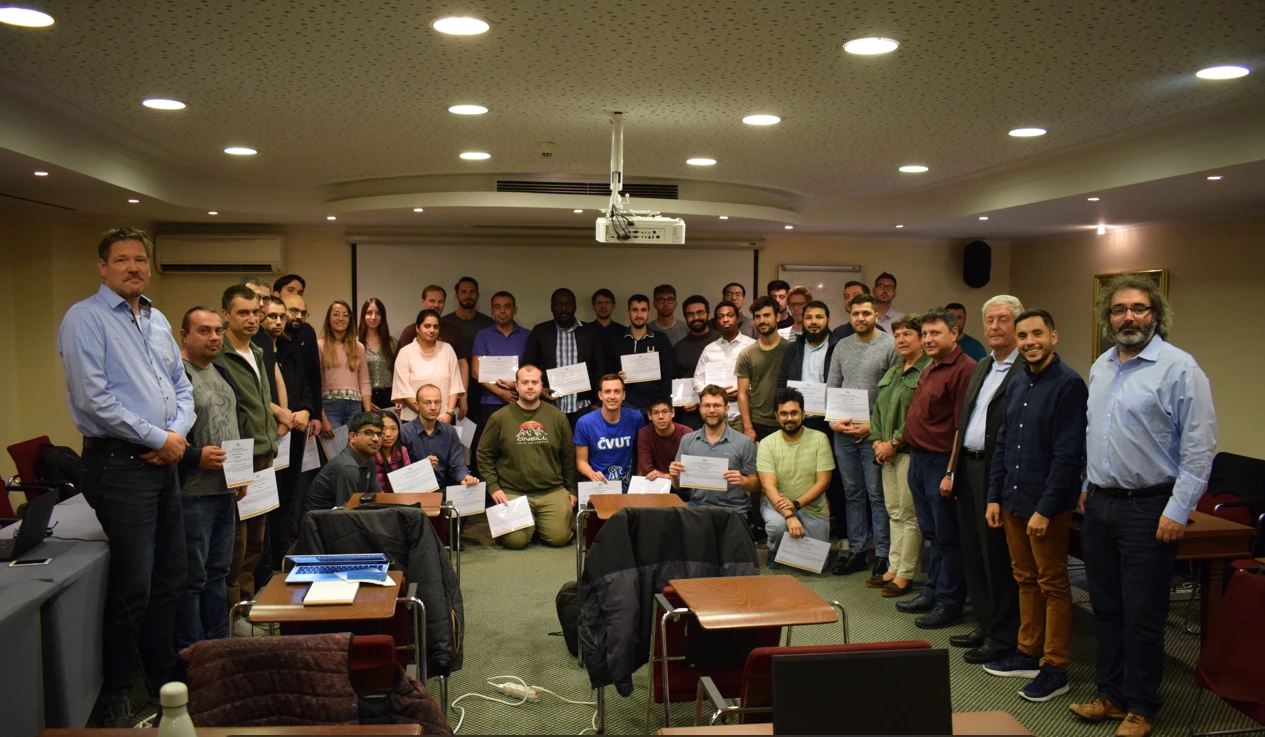
Participants in person with their certificates and outstanding lecturers.
А total of 92 participants from 21 countries registered in the CoEC South-East Europe Combustion Spring School, March 22-23, 2022 with an average participation rate of 64 students per day over the span of the school. 46 participated in person.
CoEC South-East Europe Combustion Spring School 2022 provided a high view of fundamental aspects and current challenges in combustion, as well as introduced the use of Machine Learning (ML) and High Performance Computing (HPC) to approach Exa-scale simulations of turbulent reacting flows. In this course, different methodologies to enhance the computational performance of high-fidelity combustion simulations have been introduced. The methods covered from node to system level performance optimisations and algorithms for combustion simulations. This was the first training course in a series of two CoEC seasonal schools that will take place in 2022. This introductory school to combustion allowed participants to acquire new knowledge and strengthen their understanding in a range of topics including laminar flames, turbulent combustion, ML and HPC methodologies in combustion and interactive supercomputing for in-situ analysis.
Here you can see a brief video for the school.
Autumn Event:
Catalysis for Europe's Green Transition
Workshop on advancing industrial catalysis by synergy of experiments and supercomputing simulations
November 21-24, 2022

The workshop is organised in partnership with PRACE
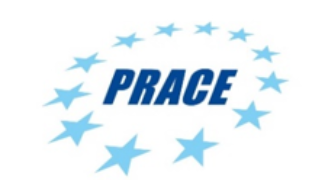

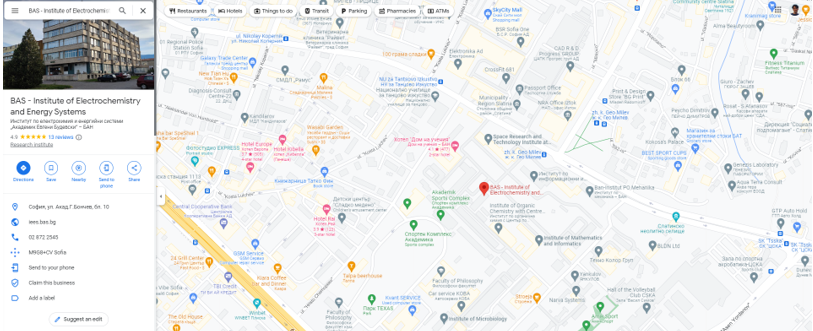
Venue: Conference Hall, Institute of Electrochemistry and Energy Systems, BAS, Acad. Georgi Bonchev Str., Bl. 10, 1113 Sofia
Description: The course is devoted to the field of catalysis and its key role in energy and materials conversion processes. The programme covers catalysis foundations as well as computational techniques that are of key importance to advance the field academically and industrially. The event is organised jointly by the Bulgarian Academy of Sciences, HITMOBIL Center of Competence at IEES-BAS, University of Sofia, Bulgaria, Daresbury Laboratory at the Science and Technology Facilities Council, UK and NCSA, Bulgaria under the partnerships of Partnership for Advanced Computing in Europe.
In the first part of the school, invited talks will address the most advanced hydrogen production technologies (generation of grey, blue, and green hydrogen), electrocatalysis in fuel cells, photocatalytic processes, biocatalysis, and bioelectrochemistry. Leading experts in the field will present the latest research achievements, the contemporary commercial technologies, and the prospective pathways toward successful transformation from carbon based to hydrogen-based zero emission economy. The second part of the school will offer general introduction to quantum chemistry methods with special attention to density functional theory, ab initio molecular dynamics, and the supercomputing challenges related to the computational modelling of materials, used in heterogeneous catalysis. Advanced techniques like metadynamics and QM/MM will be presented by experts and discussed in the context of heterogeneous catalysis and materials modelling. The advantages of using computational simulations will be illustrated via case studies on the basis of established systems in heterogeneous and bio catalysis: transition metal nanoparticles, metal oxides, zeolites as well as enzymatic reactivity and the potential catalytic properties of metal-organic frameworks will be demonstrated.
The outcomes from this training will include knowledge transfer on the following topics:
- The role of hydrogen as an energy vector of the future
- What is a catalyst and how does it work
- The key importance of catalysis in the green energy cycle (generation-storage-reuse)
- The further needs and demands on the pathway to a clean climate friendly circular economy
- What are the main computational techniques in aid of research on catalytic reactivity and properties of materials
- Key application of computational techniques to reveal pathways for catalytic reactions
- The need of high performance computing and its challenges in related to the development and performance of computational software
Target audience: Junior as well as established researchers from Central and Eastern Europe (and associated areas) with Materials background who have not previously specialised in the field of catalysis.
Registration: Please click here.
Registration deadline: November 16, 2022.
Selection process: There is a threshold number of participants (no more than 50 registrations), a timely registration is essential. Attendees should be from institutions (universities, research centers, and companies) based in the EU or Associated Countries to the Horizon 2020 Programme. We will prioritise attendees from South-East Europe, Israel, and Ukraine as well as participants that come from other EU-13 countries.
Programme: Please, click here.
Cost: There is no registration fee. The course is free of charge.
Organising committee:
Prof. Evelina Slavcheva, Institute of Electrochemistry and Energy Systems of BAS, Bulgaria
Prof. Ilian Todorov, Daresbury Laboratory at the Science and Technology Facilities Council, UK
Prof. Petko Petkov, Faculty of Chemistry and Pharmacy, Sofia University, Bulgaria
Assoc. Prof. Peicho Petkov, Faculty of Physics, Sofia University, Bulgaria
Georgi Prangov, NCSA, Bulgaria
Contact: Georgi Prangov, NCSA, Bulgaria, email: g.prangov@ncsa.bg
CoEC Combustion Autumn School 2022
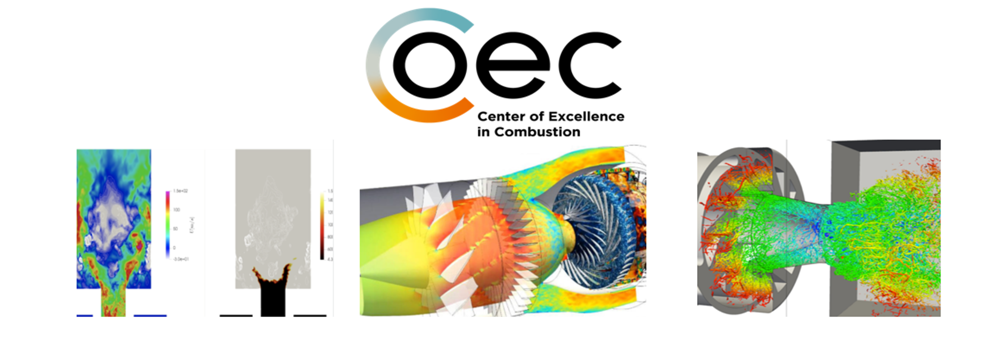
CoEC Combustion Autumn School 2022:
Combustion theory with AI/ML applications and interactive analysis
October 24-26, 2022, Crystal Palace Boutique Hotel, Sofia, Bulgaria

Venue: Shipka Conference Hall, Crystal Palace Boutique Hotel,
Address: Shipka Street 14, Sofia, 1504, Bulgaria
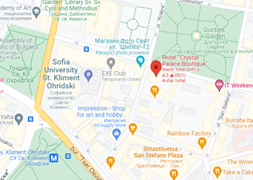
How to get to the Hotel
· From Sofia International Airport
· From Central Railway Station
· From Central Bus Station
· GPS Coordinates
o Latitude N 42.693727
o Longitude E 23.33740
Description: CoEC Combustion Autumn School 2022: Combustion theory with ML/AI applications and interactive analysis intends to present the fundamentals and current challenges in combustion, as well as to introduce the use of Machine Learning (ML) and High Performance Computing (HPC) to approach Exa-scale simulations of turbulent reacting flows. Different methodologies to enhance the computational performance of high-fidelity combustion simulations will be introduced in this school. The methods cover from node to system level performance optimisations and algorithms for combustion simulations.
This is the second training course in a series of two CoEC seasonal schools that have been planned for 2022 as part of the CoEC project. This CoEC school to combustion will allow participants to broaden their knowledge and understanding in a range of topics, including chemical kinetics in flames, soot formation in laminar, turbulent combustion, multiphase combustion of solid fuels, HPC algorithms for combustion simulation, ML and data driven modeling for turbulent reacting flows and interactive supercomputing for in-situ analysis.
The CoEC Autumn School 2022 is joint effort by NCSA (Bulgaria), CERFACS (France), BSC (Spain), Institute of Combustion Technology (ITV) - RWTH Aachen University (Germany), Juelich Supercomputing Centre (Germany), Eindhoven University of Technology (Netherlands), and Technical University of Darmstadt (Germany).
What you will learn
- General description of chemical kinetics in flames and how to handle it in computations;
- Presentation of soot formation in laminar and turbulent flames;
- Introduction to LES methods;
- Methodologies and challenges associated modeling various reacting particles like coal, aluminum, and iron;
- Introduction to Center of Excellence in Combustion (CoEC): Applying exascale computing technologies to promote and develop advanced simulation software;
- Presentation of HPC algorithms for combustion simulations;
- Introduction to AI and ML as well as ML and data driven modeling for turbulent reacting flows;
- Interactive exploration and analysis of large amounts of data with Jupyter: introduction, customisation and hands-on session
Target audience: Undergraduate and graduate students, Ph.D. students, junior researchers (academy and industry) with some knowledge in Computational Fluid Dynamics (CFD).
Selection process: There is a threshold number of participants (no more than 30 registrations), and a timely registration is essential. We will stick to the following criteria:
- 80% for attendees from institutions (universities, research centers, and companies) based in the EU or Associated Countries to the Horizon 2020 Programme and 20% for others.
- If the threshold is exceeded, we will prioritise attendees from South-East Europe, Israel, and Ukraine as well as participants that come from EU13 countries.
Programme: Please, click here.
Cost: There is no registration fee. The CoEC School is free of charge.
Registration: Please, click here
Registration deadline: October 20, 2022.
For any further information, please feel free to contact us @ g.prangov@ncsa.bg
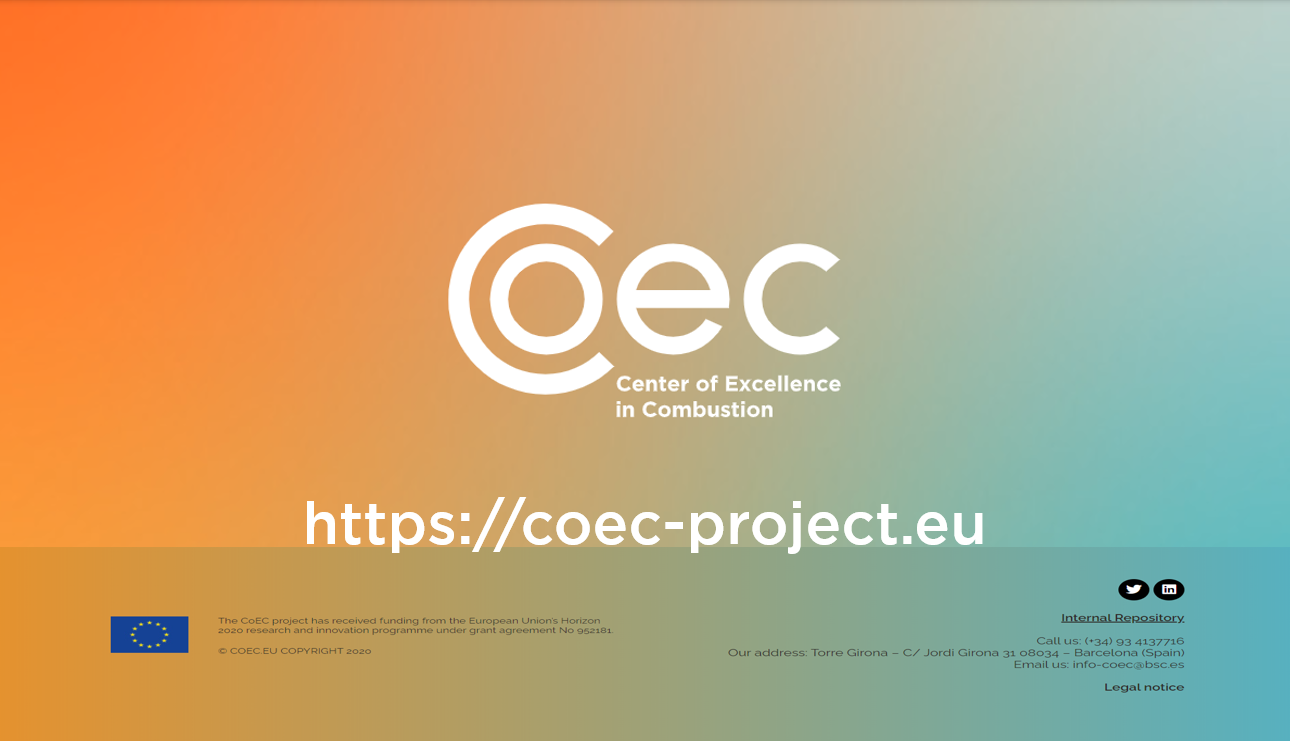
Watch video lectures of the course HPC Fundamentals for end-users
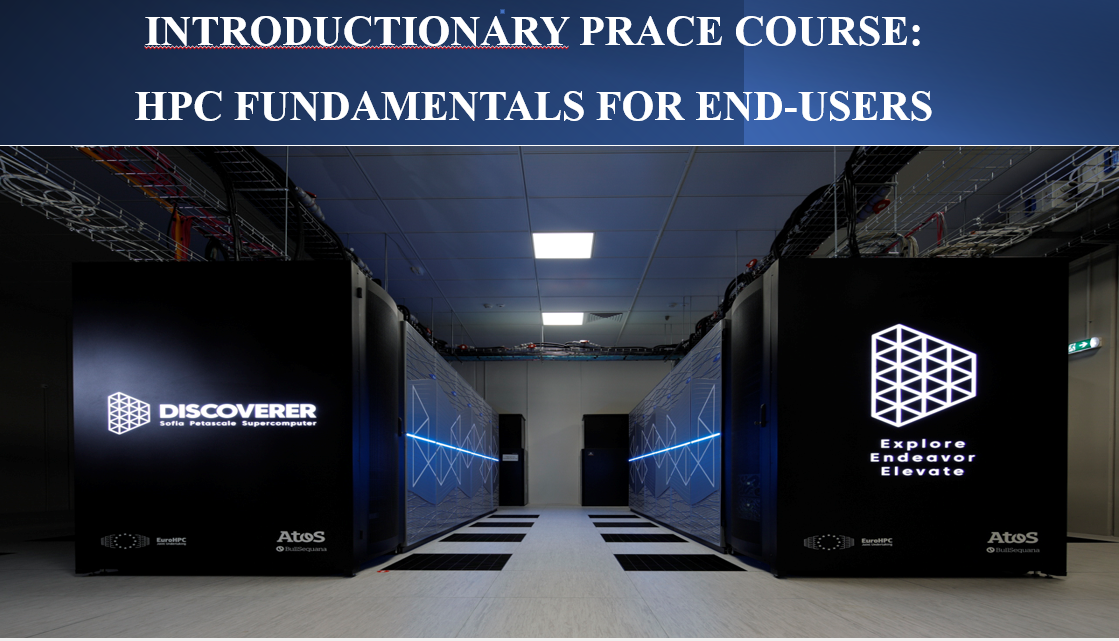
HPC Fundamentals for end-users was one of the most successful courses and that is why we upload all video lectures here, here and here.
And presentations, also. You can find them here.
The course was an introductory on how to use Discoverer supercomputer - a EuroHPC petascale system capable of executing more than 4,2 Petaflops Rmax and over 6 petaFLOPS Rpeak, by users with no prior exposure to supercomputing systems. This course was for beginner and intermediate HPC users that will allow them to master their skills, knowledge and confidence to work with supercomputing environments. The course introduced the Discoverer systems and computing architecture, including storage subsystem and computer network infrastructure. Practical sessions covered examples from different research fields such as Life Sciences, Material Science and Multiphysics simulations.
This course was a joint effort by NCSA Bulgaria and PetaSC/Sofia TechPark, Center of Excellence in Combustion (CoEC), BioExcel Centre of Excellence, STFC Daresbury Laboratory.
The objective of this first course of the series is to provide essential knowledge in modern petascale architectures and computing environments as well as the necessary fundamental skills and knowledge on how to harness the capacity and capability of supercomputing systems up to the petascale level.
More specific goals were:
- Understanding of modern HPC architectures with a focus on Discoverer system;
- Navigating through a typical HPC environment on Discoverer (terminal access and file transfer tools, usage of the module system);
- Submitting jobs by utilizing batch queuing and scheduling system SLURM;
- Working with compilers and building tools available on Discoverer;
- Compiling and running parallel codes on GROMACS, CP2K, Alya, NAMD, DL_PLOY and DL_MESO.
To create and screen for drugs with HPC and supercomputers? The mission is possible
With MD, 3D QSAR, QM-MM calculations, with software applications like
GROMACS, HADDOCK, PMX, ChemShell you can find the secrets of modelling
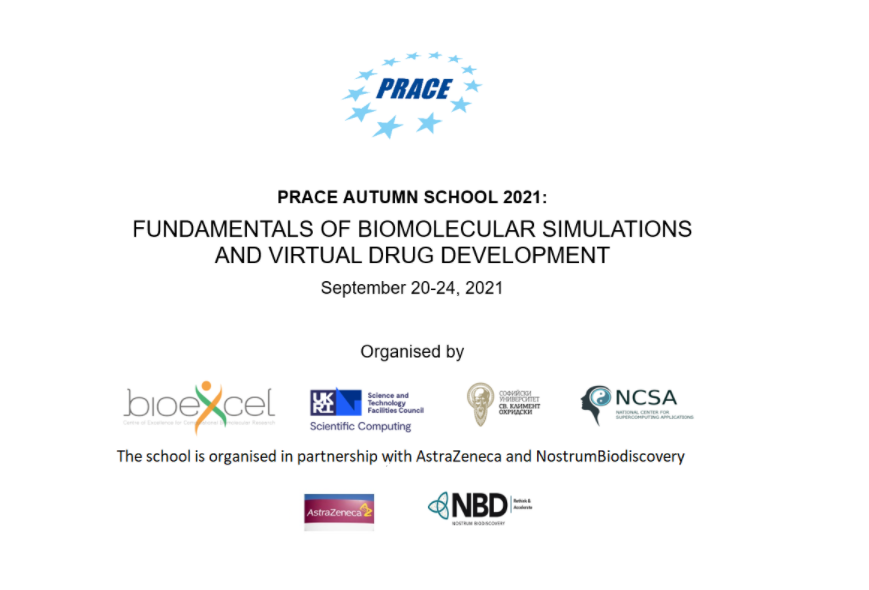
Is it possible to create, model or screen drugs with High Performance Computing and supercomputers? Yes, mission is possible, and this was proved in an interesting way by PRACE Autumn School: Fundamentals of Biomolecular Simulations and Virtual Drug Development (September 20-24, 2021).
This week-long training event introduced the fundamentals of modern methods for biomolecular simulations - molecular dynamics (MD), 3D QSAR, integrative modelling, free energy and hybrid-QM/MM calculations. Widely used software applications (GROMACS, HADDOCK, PMX, ChemShell) were presented, and their usage on HPC facilities demonstrated.
All this will be very interesting for applied scientists, who have little experience with computational methodologies and High-Performance Computing (HPC). The great interest (a total of 165 students from 25 countries) prompted us to prepare an article with the most important conclusions that can be very useful to scientists.
That is why, if you want to know:
- What is HPC? How is it different, and why is it useful? Experience running simulations on a supercomputer.
- How do we model proteins, DNA, lipids, cells and bimolecular systems? What methods and techniques are used for simulations, and how do we interpret the results?
- What are the popular software applications in the field, and how can we use them?
- Success stories: How do we screen for drugs? How do we study bimolecular phenomena? How do we do all of that in days instead of months? Learn from leading scientists from academia and pharma companies.
Then this article is for you.
The school first lecture by Prof. Irini Doychinova introduced procedures for searching potential drug candidate via applying computational simulation. Drug design is an ensemble of in silico methods and techniques for analyses and designing of novel molecules with desired properties and activities as potential drug candidates. It emerged in the early 1960s with studies on the relationships between chemical structure and bioactivity. Over the years, the drug design has been developed to comprise a wide range of methods for ligand-based and structure-based approaches for data analyses and visualization of ligand-macromolecule interactions. The present lecture describes the important place of drug design in the modern drug discovery and development, the major achievements in the field, the current state of the art and future expectations.
Centre of Excellence BioExcel was introduced by Dr. Rossen Apostolov. Over the last decades, Europe has invested heavily in the development of world-leading HPC infrastructure in particular the PRACE Tier-0 and Tier-1 machines. Much of the computational research communities, however, are not ready to make efficient use of the machines. Since 2015, BioExcel Centre of Excellence, one of the co-organizers of this school, has been developing key software applications, used extensively for computational biomolecular research, and preparing them for extreme-scale computing production operations. Most of those core applications have been covered in the program of the HPC school. The center is also developing workflow platforms and providing environments for much improved user-friendliness of the codes and opportunity to execute tailored runs.
The topic of parallel paradigms was presented by Dr. Valentin Pavlov – why are they needed, what are the different ways an HPC system can be used to carry out parallel work, tips for setting up and configuring each of the levels, basic introduction to what MPI and OpenMP is as well as advices for the end-users how to split their work.
Following two lectures by Prof. Emanouil Atanassov and Prof. Ivan Dimov covered the way to gain access to HPC system and provided a brief tour of the newest supercomputing system in Bulgaria - Discoverer.
The classical computational method of molecular mechanics was introduced by Prof. Anela Ivanova, together with some elements from statistical thermodynamics and provided a general step-by-step scheme on how to conduct a biomolecular simulation. This included: how to choose the level of detail of molecular models, the appropriate force field and simulation method, the correct thermodynamic ensemble. Then, the main part of the lecture was devoted to acquainting the audience with the fundament of the Molecular Dynamics method – presenting the equations of motion and the ways to integrate them, how to maintain constant temperature and pressure, how to calculate interaction forces efficiently and how to impose restraints and constraints. Finally, a note on the possible analysis of results was made, the advantages and drawbacks of the method were summarized, and its applicability discussed.
Following the molecular dynamics introduction, Assoc. Prof. Peicho Petkov provided an overview of some basic functionalities of the GROMACS MD software package that enable the users to parametrize a molecule/s with a force field, set a box with optimal shape and dimensions, add solvent molecules and ions to the simulation box, equilibrate the resulting molecular system and finally run production MD simulations. Special attention is paid to the available algorithm and popular practices. During the practical session there was conducting MD simulation on a remote HPC system. The participants were briefly introduced how to connect to an HPC system and do file transfers between local and remote file system/s via SSH, how to prepare scripts for, submit and monitor SLURM jobs. An example of MD simulation protocol for peptide in water in physiological conditions was demonstrated mentioning different approaches for actions / manipulations to be done locally or remotely for preparing and running MD simulations on a remote HPC system.
Biomolecular simulation based free energy calculations have become a standard technique in the field of computational chemistry. The method is frequently applied in drug discovery process to identify lead compounds or optimize already available ligands. Furthermore, the ability to accurately predict effects of amino acid mutations on protein stability and protein-protein interactions allows for an efficient rational protein engineering. In a talk Dr. Vytautas Gapsys provided a general overview of the molecular dynamics based free energy calculation methods. Subsequently, numerous applications were showcased to provide both theoretical and practical understanding of the introduced methods. The demonstrated applications highlighted amino acid mutations for protein folding free energy prediction and drug resistance studies, nucleotide mutations to probe for the changes in the protein-DNA binding, ligand modifications to predict protein-ligand binding affinities. In the subsequent practical session, open source Gromacs and PMX software packages were used to allow for a hands-on experience in predicting ligand-protein binding free energy change upon ligand modification. The participants were guided through a tutorial in which the essential steps for such an investigation step were performed.
Molecular Dynamics simulations have matured to a level where they are routinely applied to address various problems in early drug discovery in the pharmaceutical industry. In his presentation, Dr. Christian Margreitter from AstraZeneca described key bottle-necks in the context of de novo generative design using state-of-the-art Deep Learning methods with a focus on how structural modelling in general and Molecular Dynamics in particular can close these gaps. Prominent examples of use cases include the calculation of relative and absolute (binding) free energies and conformational sampling, both for small molecules and so-called "new modalities". We expect that the increase in computational resources, improved protocols and more accurate force fields together with automated, stable workflow execution will allow us to achieve even bigger impact on drug discovery projects in the near- to mid-term future.
Prof. Alexandre Bonvin showed how one could credibly evaluate drug molecules interact with their target receptors in the body through the HADDOCK docking server. The prediction of the quaternary structure of biomolecular macromolecules is of paramount importance for fundamental understanding of cellular processes and drug design. In the era of integrative structural biology, one way of increasing the accuracy of modelling methods used to predict the structure of biomolecular complexes. We have developed for this purpose a versatile information-driven docking approach HADDOCK (http://www.bonvinlab.org/software). The lecture was followed by an online tutorial illustrating the use of the HADDOCK webportal (https://wenmr.science.uu.nl/haddock2.4) for the modelling of a protein-protein complex based on NMR chemical shift perturbation data small-angle, X-ray scattering and cryo-electron microscopy experiments. HADDOCK can integrate information derived from biochemical, biophysical or bioinformatics methods to enhance sampling, scoring, or both.
During the fourth day, STFC Daresbury Laboratory team - Prof. Ilian Todorov, Dr. Tom Keal, Dr. Kakali Sen, and Dr. You Lu - demonstrated the capabilities of the ChemShell for designing the structure and properties of complex biomolecular complexes.
Introduction to ChemShell
The introductory lecture by Tom Keal covers the concepts of multiscale QM/MM modelling and gives an overview of the ChemShell package. The talk gives guidance on how to perform basic chemical tasks in ChemShell, including geometry optimisations using the DL-FIND optimisation library, for small molecule systems using both QM and QM/MM simulations. A live demo shows how ChemShell is compiled and run in practice using examples from the online tutorial.
Biomolecular modelling with QM/MM
This lecture takes an applicant's view on how to perform QM/MM calculations on biomolecular systems using Chemshell. Kakali Sen's lecture starts with a short introduction on the usefulness of QM/MM to study biomolecular systems with a focus on enzymes. It is then followed by a workflow that is necessary to prepare the system (enzyme) under investigation and the general considerations of key parameters involved in carrying out the QM/MM calculations. Finally, detailed case study of three applications showing the benefit of using QM/MM calculation is provided.
The Py-ChemShell biomolecular workflow
In this session You Lu explains the Py-ChemShell implementation of the biochemical simulation workflow. A real-life case study of the P450 enzyme is demonstrated with code running from the crystal structure preparation to the whole solvation procedure, and to the QM/MM setup and single-point/geometry-optimisation calculations.
The school presented several illustrations of using HPC for biomolecular and applied research:
In silico study of the anti-inflammatory action of heparin within the COVID-19 context
We perform in silico study of the ability of low-molecular-weight heparin (LMWH) to inhibit both IFNγ and IL-6 signalling pathways. While heparin’s binding affinity to these cytokines is well-known, the molecular mechanism of its impact on their biological activity has not been studied in detail. Our results show that LMWH is able to fully inhibit the interaction of IFNγ with its cellular receptor, thus blocking the IFNγ signalling pathway. It also influences the biological activity of IL-6 by preventing the formation of the IL-6/IL-6Rα/gp130 signalling complex. These findings shed light on the molecular mechanism of the anti-inflammatory action of LMWH, relating it to the impairment of the biological activity of these cytokines, and underpin heparin’s ability to influence favourably conditions characterised by overexpression of the latter. Such conditions are associated with autoimmune diseases, but also with inflammatory processes, in particular with COVID-19. Our results put forward heparin as a promising means for prevention and suppression of the development of severe CRS in acute COVID-19 patients and encourage further investigations on its applicability as an anti-inflammatory agent.
Different approaches for finding ligands inhibiting the NSP10/NSP16 complex of the SARS-CoV-2
We reported our approach, focused on finding a ligand capable to competitively inhibit the NSP10/NSP16 of SARS-CoV-2 by blocking its SAM pocket. In this ambitious task we try to find such a ligand that can bind to SAM pocket from the existing pools of drugs, drugs candidates, metabolites or just commercially available compounds along with constructing new virtual compounds. We also demonstrate the process of optimizing methodology to evaluate binding energies good enough to distinguish the best ligands. To fulfill this task, we define the best working model of NSP10/NSP16 SAM pocket, to unify the optimal method for scoring of ligands-NSP16 interaction and after that we use several docking procedures for sieving existing pools of structures and several methods for generating the new ones. Emphasis is placed on relatively simple for synthesis compound with little or no asymmetric carbon atoms or which asymmetric carbon atoms are easily available fragments. The best ligands as a result of our workflow, are on the way of further refinement and we hope some of them will be helpful for further drug design as a CoViD drug.
Ligand- and structure-based studies of natural flavonoids from the plant Silybum marianum
Natural products have been a rich source for medical preparations since antiquity and nowadays they continue to provide inspiration for modern drug discovery. Such an example is the silymarin extract from the medical plant Silybum marianum (milk thistle), that is native to Bulgaria and is well-known for its favorable effect on liver, cardio and biliary diseases. However, the ADMET (absorption, distribution, metabolism, excretion, toxicity) properties of flavonolignans, as well as their mechanisms of action, respectively a large part of their target proteins in the human body, are not completely defined. The presented case studies focused on prediction of gastrointestinal absorption and potential novel protein targets of flavonolignans from milk thistle, using ligand- and structure-based molecular modelling methods. According to predictions performed using an in-house QSAR (quantitative structure activity relationship) model for PAMPA (parallel artificial membrane permeability assay) permeability, the main biologically active flavonolignans in milk thistle are highly permeable in the gastrointestinal tract, which is a good prerequisite for sufficient bioavailability. Docking stimulations in the ligand-binding domain of the human estrogen receptor alpha (ERɑ) showed that the main flavonolignans in milk thistle, silybins A and B, interact stereospecifically with the protein, which is consistent with and explains results from experimental studies of ERα-mediated activity of silymarin. The chemical similarity between flavonolignans and drugs with known mechanism of action was evaluated, and docking studies were performed to select potential common protein targets for the drugs and flavonolignans (BRAF kinase and Smoothened).
Could FE calculations with GROMACS be faster? NostrumBiodiscovery's attempt to achieve this goal
In this presentation Dr Aristarc Surinach introduces the development of a protocol to perform fast and accurate free energy calculations using GROMACS and PMX. This work was done in collaboration with BioExcel partners and pretends to create a workflow to accelerate the lead optimization stage of the drug discovery process, making it possible to easily calculate protein ligand relative binding affinities. The presentation pretends to explain the importance of the different steps of the workflow, its optimization and validation, and show the results.
Clustering of doxorubicin and its interaction with bio-polymers (alginates)
Doxorubicin is an anthracycline antibiotic derived from the acti-nobacteria Streptomyces peucetius var. caesius. The drug possesses a broad-spectrum of anticancer activity, including breast, ovarian, lung, bladder cancer etc. Chitosan/alginate nanoparticles are attractive platform for doxor-ubicin loading since both polysaccharides are biocompatible, biode-gradable and non-toxic. In order to clarify the interactions between the drug and sodium alginate we performed series of classical molecular dynamic simulations using various ratios between the two components in water environment. Classical molecular dynamic simulations, performed here, revealed that the high encapsulation efficiency (above 90%) of doxorubicin in alginate/chitosan nanoparticles was mainly due to electrostatic interaction between doxorubicin and sodium alginate, although dipole-dipole and hydrophobic interactions might also contribute.
Selectivity of binding of vector molecules to the folate receptor-alpha observed by molecular dynamics
The lecture illustrated the application of atomistic molecular dynamics simulations on the example of studying the process of binding of folic acid and several of its bioactive derivatives to their target folate receptor-a. The construction of the models of the ligands and of a receptor-embedded lipid bilayer (modelling a cancer cell membrane) and the protocol for running MD simulations for these models were explained. The most important results obtained for the unbound systems were summarized. Then, the outcome from MD simulations revealing the mechanism of binding of the ligands to the receptor was presented and discussed, rationalizing the differences between the molecules. Both data for free ligands and for such carrying a bioactive drug cargo were shown.
Molecular dynamics simulations of fenofibrata solubilization into bile salt and fatty acids micelles
In the presented study, atomistic molecular dynamic simulations of taurodeoxycholate micelle formation (TDC) and solubilization of fenofibrate (FFB) in the resulting micelles are performed in the absence and presence of sodium salts of fatty acids (myristic, oleic acid and stearic). The systems are modeled under conditions as close as possible to the experimental ones in terms of electrolyte concentration, temperature and ratio between different types of molecules, as their concentration is increased 5 times. For each system, trajectories with a length of 300 ns are generated, which are analyzed in terms of micelle formation kinetics. From the last 150 ns, the size of the obtained micelles is estimated, the percentage of different types of molecules in the case of mixed micelles of bile and fatty acids and the solubilization capacity for the FFT drug. Theurodeoxycholate is found to form secondary micelles (over 9 molecules in size) with an average aggregation number (Nagg) of 19, which is in full agreement with the experimental data Nagg (TDC) = 18. When monomers of the sodium salt of fatty acids are added to the TDC micelles, one part of them associates with the TDC micelles to form mixed micelles and another part assemble to form pure micelles. Regarding the solubilization of fenofibrate, it is found that it is higher in the presence of oleic and myristic acids and the effect is greater with oleic than myristic acid, and there is no effect of the stearic acid. The obtained results are in full agreement with the experimental data.
All these themes are very actual and provokes great interest not only for the pandemic. The majority of the participants (88%) pointed out that they would recommend this PRACE Autumn School 2021. Around 62% of them have confirmed that they intend to use the presented tools in their future endeavours.
Maybe because of that, the received feedback by the participants and the huge interest expressed in the school by more than 230 people around world, the PRACE Autumn School 2021 can be considered as a real success that deserves repeating it.
In order for this knowledge to reach more specialists, almost all the lectures were uploaded on the website of the Centre of Excellence BioExcel and on their YouTube channel (here). You can find the link on the NCSA website (here), also.
The video lectures from
PRACE Autumn School
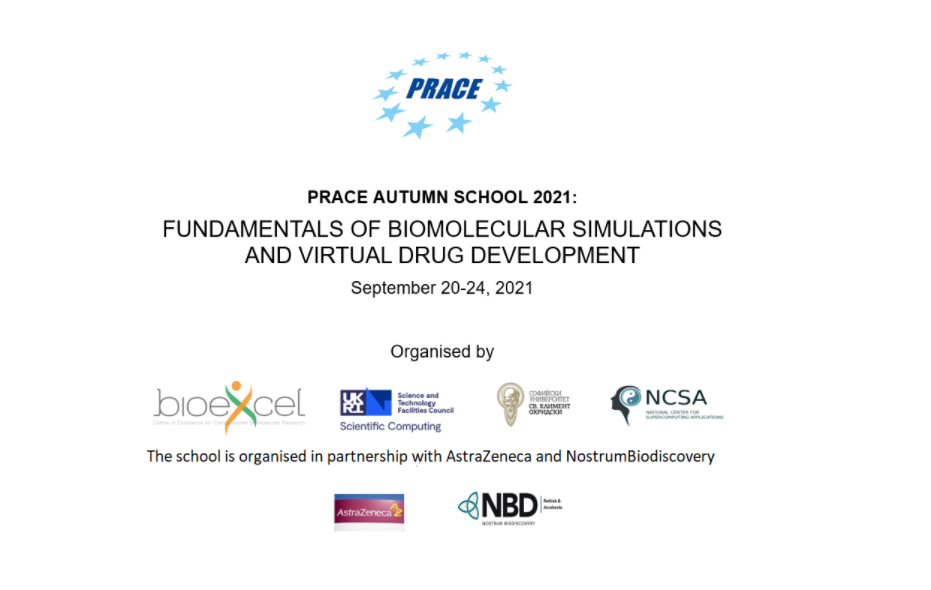
Video lectures from one of our most successful schools can be found on the YouTube channel of Bioexcel here.
165 students from 25 countries were registered in the PRACE Autumn School 2021. According to the survey, participants mentioned that the organisation was very good or excellent. There was predominant agreement (88%) that the lectures were clearly presented and comprehensible with 91% of the respondents pointing out that the demonstrations were a valuable contribution to the school and the content matched the course description. Additionally, the majority of the respondents agreed that the balance of theoretical and practical content across the school was “about right” with a slight inclination to be “too theoretical”.
The majority of the respondents (88%) pointed out that they would recommend this PRACE Autumn School 2021 and around 62% of them have confirmed that they intend to use the presented tools in their future endeavours.
The school provided an introduction to the fundamentals of modern approaches employed for modelling and prediction of the behaviour of bioactive systems and functional materials – molecular dynamics (MD), 3D Quantitative structure-activity relationship (3D QSAR), and QM/MM (Quantum mechanics/Molecular mechanics). The school focused on docking and MD-based free energy calculations and applying Quantum mechanics/Molecular mechanics (QM/MM) methods to study enzymatic reactions.
The capacity of HPC facilities for performing such simulations was outlined with an emphasis on commonly applied parallelisation techniques in computational science. All lectures and computational methods were presented in a way accessible to applied scientists who are not specialists in those fields but would like to broaden their research scope. Lectures were supplemented by demonstrations using GROMACS, HADDOCK and ChemShell - widely used software packages for HPC modelling and simulations. The target audience was junior researchers (post-graduates and post-docs) with a background in natural sciences and in particular, pharmacy, biochemistry and biophysics, working at European academic research institutions and industry.
The school was a joint initiative of PRACE, the BioExcel Centre of Excellence, STFC Daresbury Laboratory, NCSA Bulgaria, and Sofia University.
PRACE course:
HPC - Intermediate Concepts for end-users
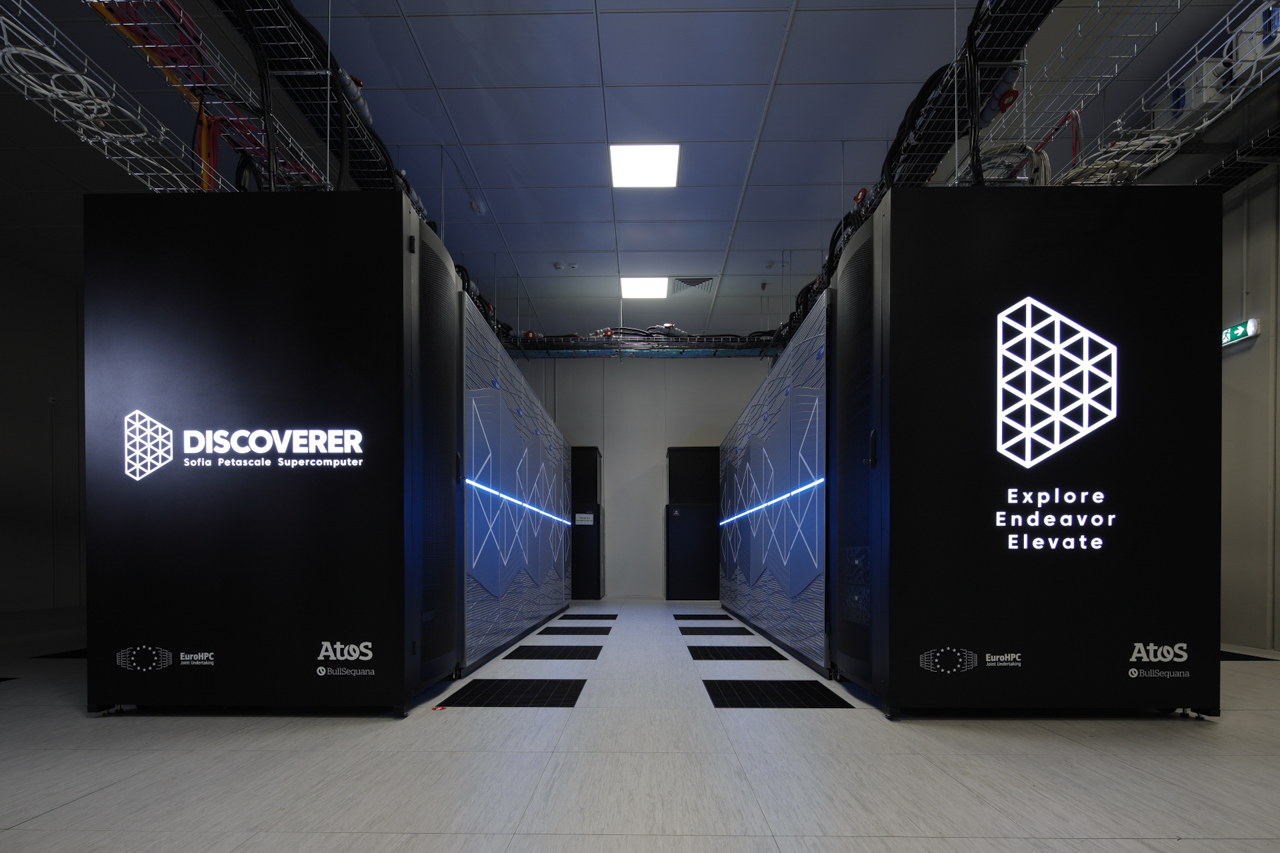
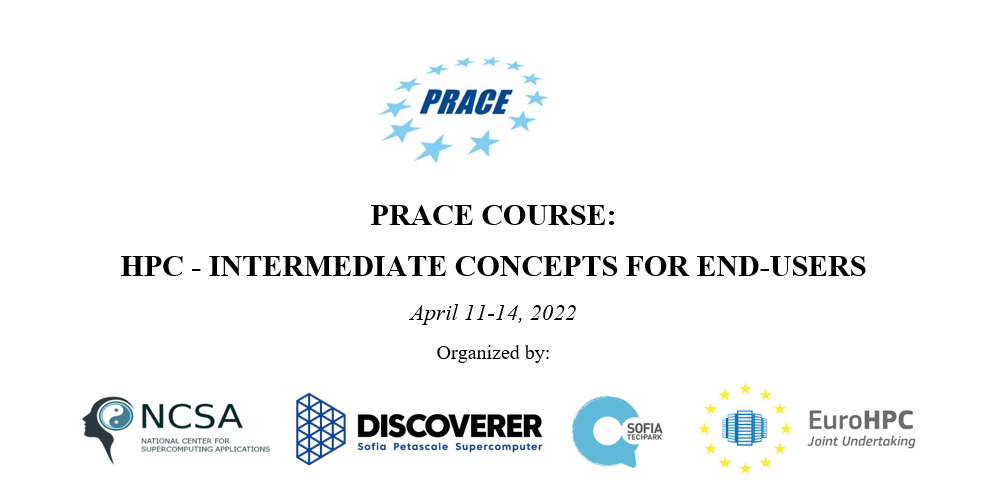
Venue: Online via Zoom
Description: The PRACE Course: “HPC - Intermediate concepts for end-users” is intended for researchers and IT specialists having basic knowledge of HPC usage wishing to advance in the field. It builds on the top of the first PRACE Course HPC Fundamentals for end-users, February 1-4, 2022 and extends it by discussing the profiling and scaling of parallel applications, which is extremely important for efficiently running simulations on Petascale systems. The course starts with an introduction to modern build tools and parallel frameworks including TBB, OpenACC and DC++. It then proceeds to present the concept of profiling parallel applications, techniques and important metrics, demonstrated with an example of a simple implementation of the Conjugate Gradient algorithm. The third day is dedicated to weak and strong scaling procedures, demonstrated on a state-of-the-art scientific parallel application. The last day is fully dedicated to the versatile use of Python in HPC. PetaSC/Sofia TechPark will graciously provide Discoverer compute resources for the hands-on sessions. The second PRACE course is a joint effort by NCSA Bulgaria and PetaSC/Sofia TechPark Bulgaria.
Target audience: Under-graduate and graduate students, Ph.D. students, junior researchers (academy and industry), IT specialists, Software Engineers or anyone who wants to use Discoverer petascale supercomputer system in their research & business activities.
Prerequisites: Requirements for the participants: fundamental usage of HPC systems, including compiling and building parallel codes, MPI, OpenMP, and experience with Linux operating systems.
Registration: Please click here.
Registration deadline: April 6, 2022.
Selection process: There is a threshold number of participants (no more than 40 registrations), and a timely registration is essential. Attendees must be from institutions (universities, research centers, and companies) based in the EU or Associated Countries to the Horizon 2020 Programme. We will prioritise attendees from South-East Europe, Israel, and Ukraine as well as participants that come from other EU13 countries.
Programme: All details you can see here.
Cost: There is no registration fee. The course is free of charge.
Organising committee coordinators: Assoc. prof. Dr. Peicho Petkov (NCSA) and Prof. Dr. Simeon Stoyanov (PetaSC).
Contact: g.prangov@ncsa.bg


South-East Europe Combustion Spring School 2022
March 22-23, 2022
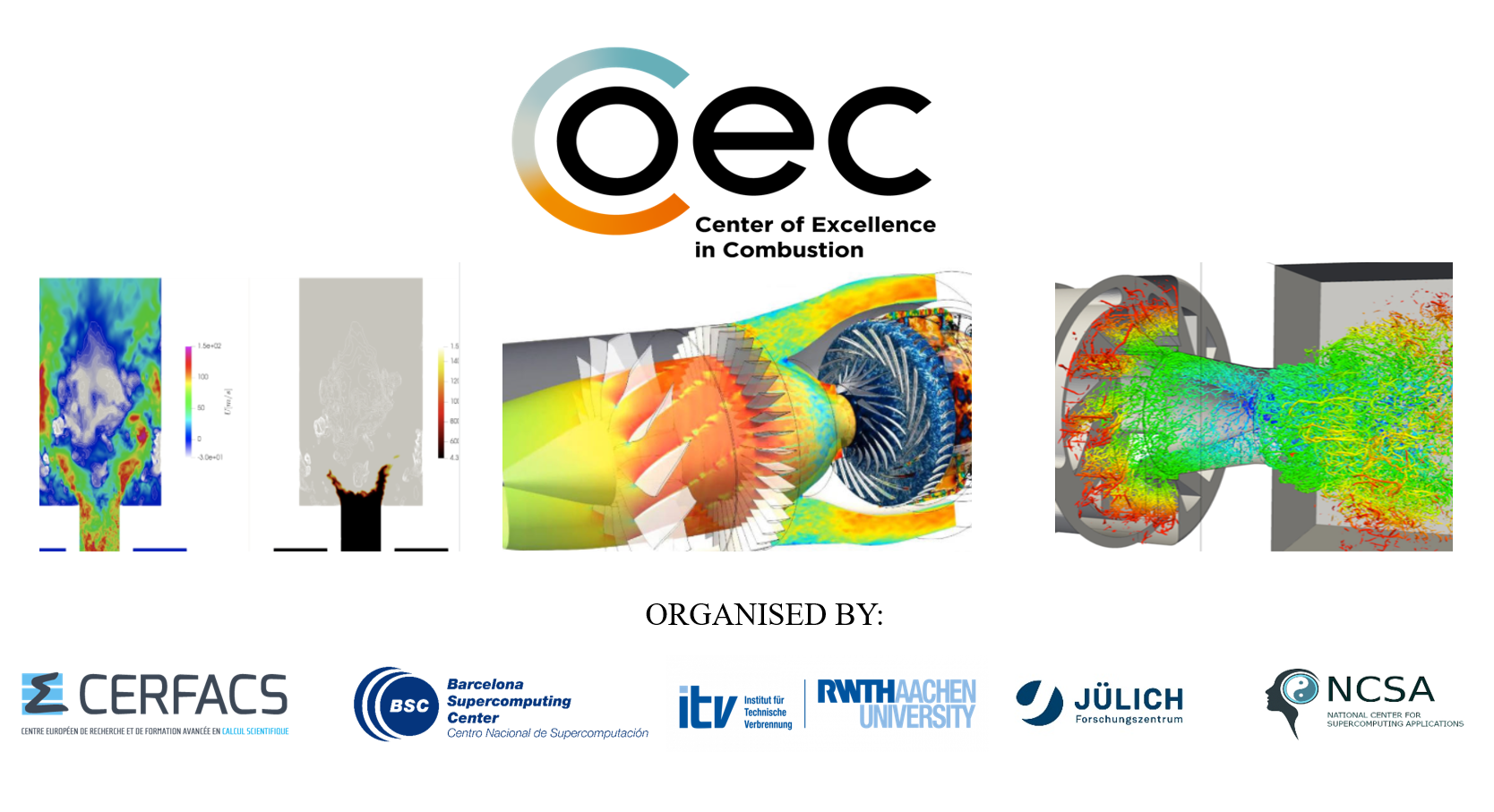
Venue: Online via Zoom
Description: South-East Europe Combustion Spring School 2022 intends to give a high view of fundamental aspects and current challenges in combustion, as well as to introduce the use of Machine Learning (ML) and High-Performance Computing (HPC) to approach Exa-scale simulations of turbulent reacting flows. In this course, different methodologies to enhance the computational performance of high-fidelity combustion simulations will be introduced. The methods cover from node to system-level performance optimisations and algorithms for combustion simulations. This is the first training course in a series of two CoEC seasonal schools that will take place in 2022. This introductory school to combustion will allow participants to acquire new knowledge and strengthen their understanding in a range of topics including laminar flames, turbulent combustion, ML and HPC methodologies in combustion and interactive supercomputing for in-situ analysis. In the following up CoEC School for 2022, we will build on the ground of the first school by extending the scope and topics covered and by including a number of hands-on exercises.
The CoEC Spring School 2022 is a joint effort by NCSA Bulgaria, CERFACS (France), BSC (Spain), Institute of Combustion Technology (ITV) - RWTH Aachen University (Germany) and Juelich Supercomputing Centre (Germany).
What you will learn
- Basics of laminar combustion including equations, combustion chemistry, flame regimes and structures;
- Understanding of phenomenology of turbulence and turbulent combustion;
- Presentation of turbulent combustion models for the simulation of combustion chambers;
- Introduction to Center of Excellence in Combustion (CoEC): Applying exascale computing technologies to promote and develop advanced simulation software;
- Introduction to ML algorithms and to combustion models that will benefit from ML;
- Presentation of modelling of chemical mechanisms through the artificial neural network;
- Presentation of modelling turbulence and scalar fluxes in numerical simulations through a convolutional neural network and super-resolution generative adversarial network.
Target audience: Under-graduate and graduate students, PhD students, junior researchers (academy and industry) with some knowledge in Computational Fluid Dynamics (CFD).
Selection process: There is a threshold number of participants (no more than 90 registrations), timely registration is essential. We will stick to the following criteria:
- 80% for attendees from institutions (universities, research centers, and companies) based in the EU or Associated Countries to the Horizon 2020 Programme and 20% for others.
- If the threshold is exceeded, we will prioritise attendees from South-East Europe, Israel, and Ukraine as well as participants that come from EU13 countries.
Programme: Please click here
Cost: There is no registration fee. The CoEC School is free of charge.
Registration: Please click here
Registration deadline: March 16, 2022.
For any further information, please feel free to contact us: g.prangov@ncsa.bg
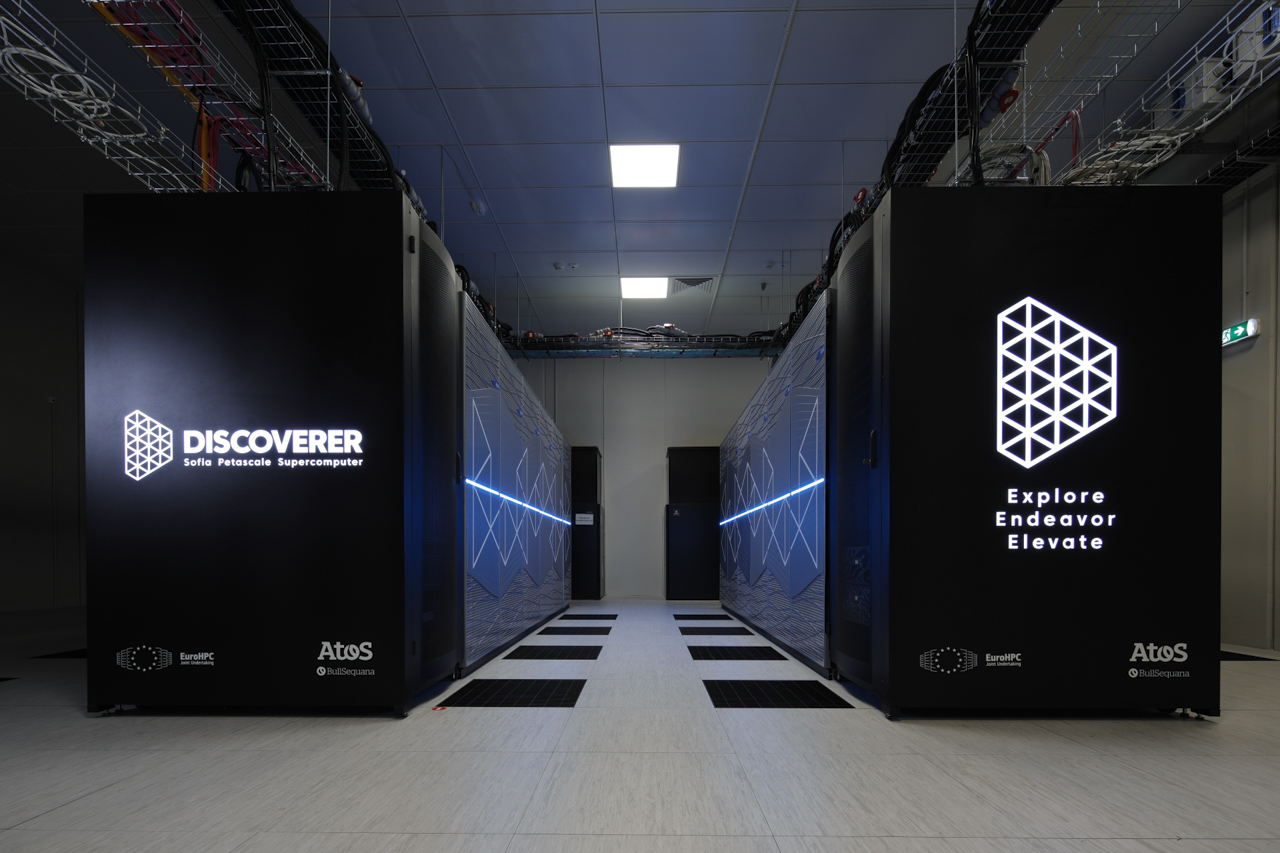
NCSA in 2021
In the video you will find the essential key points that NCSA is working on in 2021.
First, scientists at NCSA in Bulgaria performed simulations to examine these factors and laid the
groundwork for anti-virus ventilation systems. Here you can find the publication of HPCWire.com on this subject.
Second, NCSA, together with Sofia University, Bioexcel, STFC Daresbury Laboratory, AstraZeneca,
and Nostrum Biodiscovery was a co-organizer of PRACE Autumn School 2021 Fundamentals
of Biomolecular Simulations and Virtual Drug Development.
The result - a total of 165 students from 25 countries registered in the PRACE
Autumn School 2021.The details you can find here and in the NCSA presentation.
The third key event was the inauguration of the Discoverer supercomputer on October 21, 2021.
EuroHPC petascale system capable of executing more than 4.2 Petaflops
Rmax and over six petaFLOPS Rpeak. More details you can find in the presentation and here.
From the entire team at NCSA, have a Merry Christmas and a prosperous New Year!
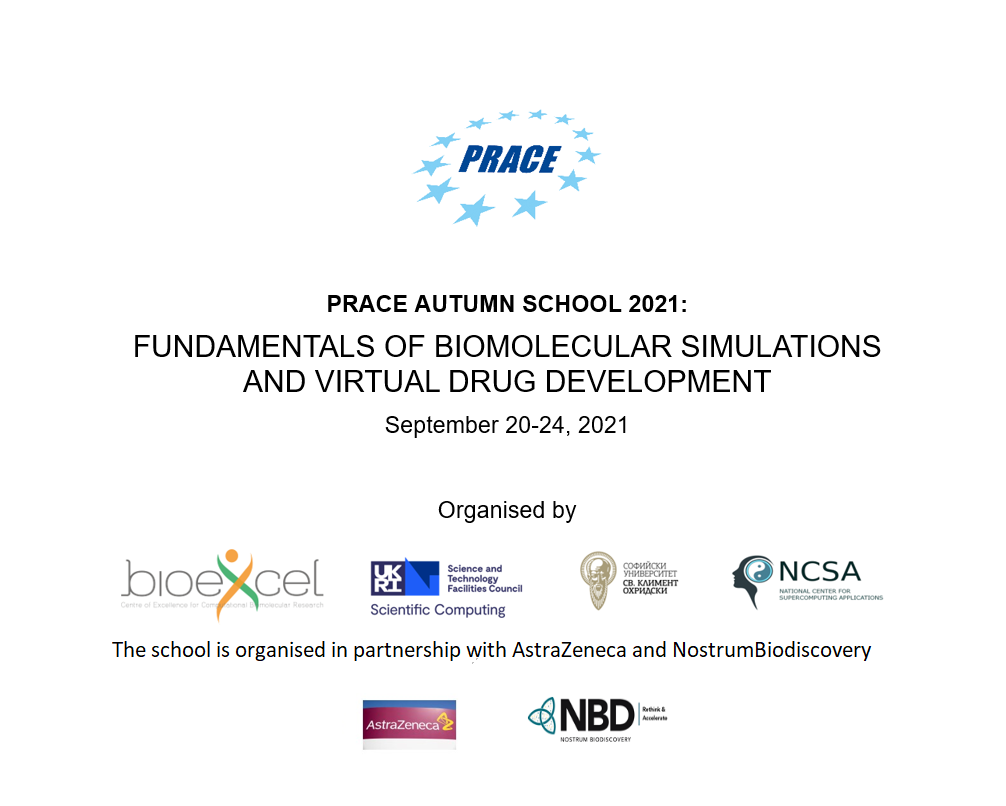
The school will provide an introduction to the fundamentals of modern approaches employed for modelling and prediction of the behaviour of bioactive systems and functional materials – molecular dynamics (MD), 3D Quantitative structure-activity relationship (3D QSAR), and QM/MM (Quantum mechanics/Molecular mechanics). We will focus on docking and MD-based free energy calculations and applying Quantum mechanics/Molecular mechanics (QM/MM) methods to study enzymatic reactions.
The capacity of HPC facilities for performing such simulations will be outlined with an emphasis on commonly applied parallelisation techniques in computational science. All lectures and computational methods will be presented in a way accessible to applied scientists who are not specialists in those fields but would like to broaden their research scope. Lectures will be supplemented by demonstrations using GROMACS, HADDOCK and ChemShell - widely used software packages for HPC modelling and simulations. The target audience is junior researchers (post-graduates and post-docs) with a background in natural sciences and in particular, pharmacy, biochemistry and biophysics, working at European academic research institutions and industry.
Trainees from Central and Eastern Europe are especially welcome. Participation is free.
The school is a joint initiative of PRACE, the BioExcel Centre of Excellence, STFC Daresbury Laboratory, NCSA Bulgaria, and Sofia University.
The activities will be carried out online using Zoom.
You can learn more from these two videos. The first video is an intellectual property of NVIDIA. The second is created by BioExcel.
Here you can find an introduction to our school - the Swiss protocol for in silico drug design applied as a closed procedure for searching for drugs against COVID -19, which is used by Novartis and Hoffmann La Roche. This two-hour lecture is organised by the Swiss Institute of Bioinformatics.
Registration
Please visit PRACE website and fill out the registration form
Programme
10:00 Opening Zoom meeting
Day 1, September 20:
HPC for applied research
All indicated times are in the Central European Summer Time (CEST) zone (GMT +2)
09:50 - 10:00
Opening
Prof. Anela Ivanova,
Faculty of Chemistry and Pharmacy, Sofia University, Bulgaria
Moderator: Prof. Anela Ivanova,
Faculty of Chemistry and Pharmacy, Sofia University, Bulgaria
10:00 - 10:50
Lecture: Drug Design: Past, Present and Future
Prof. Irini Doychinova, Faculty of Pharmacy, Medical University, Sofia, Bulgaria
10:50 – 11:00
Lecture: BioExcel Centre of Excellence – Advanced applications and
services for computational biomolecular research
Dr. Rossen Apostolov, KTH Royal Institute of Technology, Sweden
11:00 – 11:30
Break
11:30 -12:30
Lecture: Parallelisation paradigms: Introduction to methodologies
for parallelisation, application of MPI and OpenMP
Dr. Valentin Pavlov, Rila Solutions, Bulgaria
12:30 - 14:00
Lunch break
Moderator: Prof. Nevena Ilieva,
Institute of Information and Communication Technologies,
Bulgarian Academy of Sciences
14:00 - 15:30
Training (demonstration)
Prof. Emanouil Atanassov, The Institute of Information and Communication
Technologies at the Bulgarian Academy of Sciences
15:30 - 16:00
Break
16:00 - 16:30
Discoverer EuroHPC supercomputer
Prof. Ivan Dimov, Member of EuroHPC Governing Board
Day 2, September 21:
Biomolecular simulations with Molecular Dynamics
All indicated times are in the Central European Summer Time (CEST) zone (GMT +2)
Moderator: Dr. Michael Seaton, STFC Daresbury Laboratory, UK
09:30 - 10:30
Lecture: Basics of Molecular Dynamics
Prof. Anela Ivanova,
Faculty of Chemistry and Pharmacy, Sofia University, Bulgaria
10:30 – 11:00
Break
11:00 – 12:00
Lecture: Introduction to Molecular Dynamics simulations with GROMACS
Asoc. Prof. Peicho Petkov,
Faculty of Physics, Sofia University, Bulgaria
12:00 - 13:30
Lunch break
Moderator: Dr. Michael Seaton, STFC Daresbury Laboratory, UK
13:30 - 15:00
Practical session: Demonstrations on how to prepare and run an MD
simulation with GROMACS on a supercomputer
Asoc. Prof. Peicho Petkov,
Faculty of Physics, Sofia University, Bulgaria,
Stoyan Iliev,
Faculty of Chemistry and Pharmacy, Sofia University
15:00 - 15:30
Break
15:30 - 16:30
Best practices and Q&A session on HPC usage of GROMACS for biomolecular simulations
Prof. Berk Hess,
KTH Royal Institute of Technology, Sweden
Day 3, September 22:
Integrative modelling, Docking and Free energy calculations of biomolecular systems
All indicated times are in the Central European Summer Time (CEST) zone (GMT +2)
Moderator: Dr. Rossen Apostlov, KTH Royal Institute of Technology, Sweden
09:30 - 10:30
Lecture: Introduction to free energy calculations with PMX
Dr. Vytautas Gapsys,
Max Planck Institute for Biophysical Chemistry, Germany
10:30 - 11:00
Break
11:00 - 12:00
Practical session: Demonstrations and hands-on session for working with PMX
Dr. Vytautas Gapsys,
Max Planck Institute for Biophysical Chemistry, Germany
12:00 - 12:30
Lecture: Application of molecular dynamics simulations in the field of drug discovery
Dr. Christian Margreitter, AstraZeneca, UK-Sweden
12:30 -14:00
Lunch break
14:00 - 15:00
Lecture: Basics of docking for drug design
Prof. Alexandre Bonvin, Utrecht University, Netherlands
&
Lecture: Introduction to HADDOCK
Prof. Alexandre Bonvin, Utrecht University, Netherlands
15:00 - 15:30
Break
15:30 - 16:30
Practical session: Demonstrations and hands-on session for working with HADDOCK
Prof. Alexandre Bonvin, Utrecht University, Netherlands
Day 4, September 23:
DL_Software and Hybrid-QM/MM approaches in biomolecular sciences via ChemShell
All indicated times are in the Central European Summer Time (CEST) zone (GMT +2)
Moderator: Dr. Kakali Sen, STFC Daresbury Laboratory, UK
09:30 - 10:00
Lecture: Introduction to Daresbury Laboratory Molecular Modelling Suite
Prof. Ilian Todorov, STFC Daresbury Laboratory, UK
10:00 - 10:45
Lecture: Introduction to ChemShell
Dr. Tom Keal, STFC Daresbury Laboratory, UK
10:45 - 11:15
Break
11:15 - 12:00
Demonstration 1: First steps with ChemShell
Dr. Tom Keal, STFC Daresbury Laboratory, Dr. You Lu, STFC
Daresbury Laboratory, Dr. Kakali Sen, STFC Daresbury Laboratory
12:00 - 13:30
Lunch break
Moderator: Dr. Tom Keal, STFC Daresbury Laboratory, UK
13:30 - 14:15
Lecture: Biomolecular modelling with QM/MM
Dr. Kakali Sen, STFC Daresbury Laboratory, UK
14:15 - 14:30
Lecture: The Py-ChemShell biomolecular workflow
Dr. You Lu, STFC Daresbury Laboratory, UK
14:30 - 15:00
Break
15:00 – 16:30
Demonstration 2: Biomolecular modelling with ChemShell
Dr. Tom Keal, STFC Daresbury Laboratory, Dr. You Lu, STFC
Daresbury Laboratory, Dr. Kakali Sen, STFC Daresbury Laboratory
Day 5, September 24:
Success stories and showcases of using HPC for biomolecular
and applied research in Central and Eastern Europe
All indicated times are in the Central European Summer Time (CEST) zone (GMT +2)
Moderator: Dr. Elena Lilkova, Institute of Information and Communication
Technologies, Bulgarian Academy of Sciences
09:30 - 10:00
Lecture: Different approaches for finding ligands inhibiting the
NSP10/NSP16 complex of the SARS-CoV-2
Asoc. Prof. Miroslav Rangelov, Institutes of Organic Chemistry with Centre of Phytochemistry,
Bulgarian Academy of Sciences, Dr. Nadezhda Todorova, Institute of Biodiversity and Ecosystem Research,
Bulgarian Academy of Sciences, Prof. Stoyan Markov, National Center for Supercomputing Applications,
Prof. Dr. José Antonio Encinar, Instituto de Investigación, Desarrollo e Innovación en Biotecnología Sanitaria de Elche (IDIBE)
10:00 - 10:30
Lecture: In silico study of the anti-inflammatory action of heparin
within the Covid-19 context
Prof. Nevena Ilieva, Institute of Information and Communication Technologies,
Bulgarian Academy of Sciences, Asoc. Prof. Peicho Petkov, Faculty of Physics, Sofia University,
Asoc. Prof. Miroslav Rangelov, Institutes of Organic Chemistry with Centre of Phytochemistry,
Bulgarian Academy of Sciences, Dr. Elena Lilkova, Institute of Information and Communication
Technologies, Bulgarian Academy of Sciences, Dr. Nadezhda Todorova, Institute of Biodiversity and
Ecosystem Research, Bulgarian Academy of Sciences,
Prof. Leandar Litov, Faculty of Physics, Sofia University
10:30 - 11:00
Break
11:00 - 11:30
Lecture: Beyond in silico simulations: A case study on acetylcholinesterase inhibitors
Dr. Mariyana Atanasova, Prof. Georgi Stavrakov, Faculty of Pharmacy, Medical University,
Irena Philipova, Faculty of Pharmacy, Medical University, Dr. Dimitrina Zheleva,
Faculty of Pharmacy, Medical University, Prof. Rumyana Simeonova, Faculty of Pharmacy,
Medical University, Prof. Spiro Konstantinov, Faculty of Pharmacy, Medical University,
Prof. Ivan Dimitrov, Faculty of Pharmacy, Medical University,
Prof. Irini Doytchinova, Faculty of Pharmacy, Medical University
11:30 - 12:00
Lecture: Ligand- and structure-based studies of natural flavonoids
from the plant Silybum marianum
Antonia Diukendjieva, Institute of Biophysics and Biomedical
Engineering, Bulgarian Academy of Sciences,
Petko Alov, Institute of Biophysics and Biomedical Engineering,
Bulgarian Academy of Sciences,
Prof. Ivanka Tsakovska, Institute of Biophysics and Biomedical Engineering,
Bulgarian Academy of Sciences,
Prof. Tania Pencheva, Institute of Biophysics and Biomedical Engineering,
Bulgarian Academy of Sciences,
Prof. Ilza Pajeva, Institute of Biophysics and Biomedical Engineering,
Bulgarian Academy of Sciences
12:00 - 12:30
PhD Aristarc Surinach,
NostrumBiodiscovery, TBD
12:30 - 14:00
Lunch break
Moderator: Dr. Nadezhda Todorova,
Institute of Biodiversity and Ecosystem Research,
Bulgarian Academy of Sciences,
14:00 - 14:30
Lecture: Clustering of doxorubicin and its interaction with bio-polymers (alginates)
Prof. Petko Petkov, Faculty of Chemistry and Pharmacy, Sofia University, Nikolay Daskalov,
Faculty of Chemistry and Pharmacy, Sofia University, Prof. Georgi Vayssilov,
Faculty of Chemistry and Pharmacy, Sofia University
14:30 - 15:00
Lecture: Selectivity of binding of vector molecules to the folate
receptor-alpha observed by molecular dynamics
Dr Gergana Gocheva, Faculty of Chemistry and Pharmacy, Sofia University,
Dr Nikoleta Ivanova, Faculty of Chemistry and Pharmacy, Sofia University,
Dr Jasmina Petrova, Faculty of Chemistry and Pharmacy, Sofia University,
Stoyan Iliev, Faculty of Chemistry and Pharmacy, Sofia University,
Ethan N. Schaber, Faculty of Chemistry and Pharmacy, Sofia University, Boyana Atanasova,
Prof. Galia Madjarova, Faculty of Chemistry and Pharmacy, Sofia University,
Dr. Nina Ilieva, Faculty of Chemistry and Pharmacy, Sofia University,
Prof. Anela Ivanova, Faculty of Chemistry and Pharmacy, Sofia University
15:00 - 15:30
Lecture: Molecular dynamics simulations of fenofibratå
solubilization into bile salt and fatty acids micelles
Fatmegyul Mustan-Borisova, Faculty of Chemistry and Pharmacy, Sofia University,
Prof. Anela Ivanova, Faculty of Chemistry and Pharmacy, Sofia University
Prof. Slavka Tcholakova, Faculty of Chemistry and Pharmacy, Sofia University
15:30 - 15:45
Closing remarks
Dr. Rossen Apostolov, KTH Royal Institute of Technology, Sweden
Organising committee
Dr. Rossen Apostolov – coordinator, BioExcel Centre of Excellence, KTH, Sweden
Georgi Prangov – assistant, NCSA
Prof. Ilian Todorov – UKRI-STFC Daresbury Laboratory, UK
Stoyan Iliev – Sofia University “St. Kliment Ohridski”, Bulgaria
Petia Petkova – assistant, NCSA
Programme committee
Prof. Dr, Anela Ivanova – coordinator, Sofia University “St. Kliment Ohridski”, Bulgaria
Prof. Irini Doychinova – Medical University Sofia, Bulgaria
Dr. Thomas Keal – UKRI-STFC Daresbury Laboratory, UK
Dr. Alessandra Villa – BioExcel Centre of Excellence, KTH, Sweden
Asoc. Prof. Peicho Petkov – Faculty of Physics, Sofia University, Bulgaria
Registration
Please fill out this form
Deadline for registrations: September 12
For any further information, please feel free to contact us.
Georgi Prangov
g.prangov@ncsa.bg
Petia Petkova
p.petkova@ncsa.bg
office@ncsa.bg
Shaping Europe’s Digital Future
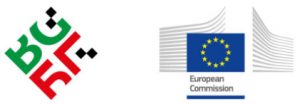
Shaping Europe’s Digital Future –Bulgarian Presidency event on High Performance Computing
Sofia, 19 April 2018
“Shaping Europe’s Digital Future – High Performance Computing for Extreme Scale Scientific and Industrial Applications” is a Bulgarian Presidency event on High Performance Computing. It will take place on 19 April 2018 at the National Palace of Culture, Sofia, Bulgaria and it is co-organised with the European Commission.
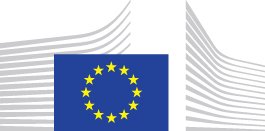
Young Researchers Event 2018
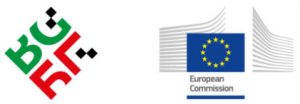
Brain models and Computation for Brain Medicine
Bulgarian Academy of Sciences, Sofia, Bulgaria
18 April 2018
This event is open to the entire scientific community but especially targets young researchers. “Young Researchers Event: Brain models and Computation for Brain Medicine” is a Bulgarian Presidency event on Human Brain Project and High Performance Computing, organised with the support of the European Commission. It will take place on 18 April 2018 at the Big Auditorium of the Bulgarian Academy of Sciences.

EuroHPC
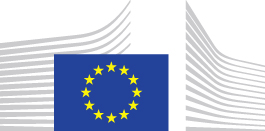
THIS IS THE BEGINNING OF THE EUROPEAN SUPERCOMPUTER (Commissioner Mariya Gabriel, 24 Hours, 22.01.2018)
Commission proposes to invest EUR 1 billion in world-class European supercomputers (Press release, Brussels, 11 January 2018)
Questions & Answers: High-Performance Computing and EuroHPC initiative (Memo, Brussels, 11 January 2018)
Formal acts adopted this morning by the Commission
“The Thinking Computer”, interview with Prof. Stoyan Markov.
In honor of its 25th anniversary, the leading publishing house „24 Hours” published a special edition of forecasts named „The next 25 years”. The interview with Prof. Stoyan Markov is entitled "The Thinking Computer".

